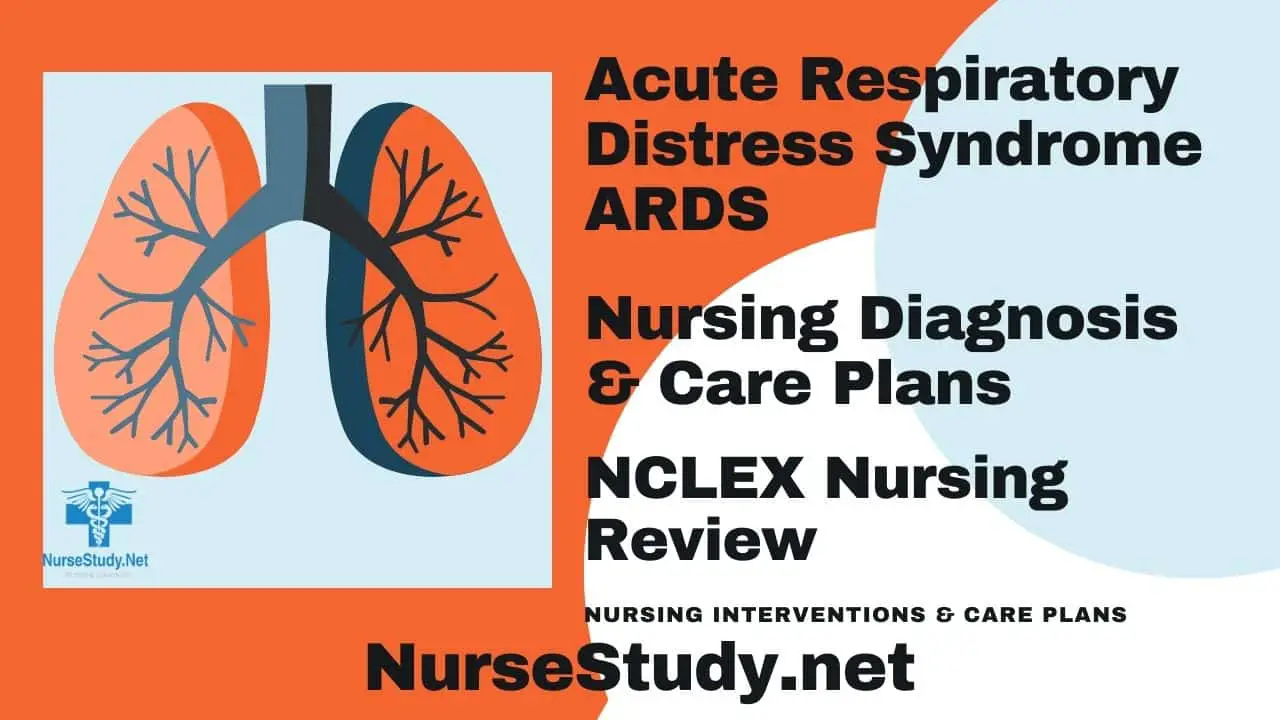ARDS is a severe respiratory condition characterized by the rapid onset of widespread inflammation in the lungs. This inflammation leads to:
- Reduced lung compliance
- Impaired gas exchange
- Severe hypoxemia
- Bilateral infiltrates on chest imaging
Pathophysiology of ARDS
The progression of ARDS occurs in three distinct phases:
Exudative Phase (Days 1-7)
- Increased alveolar-capillary membrane permeability
- Protein-rich edema fluid fills alveoli
- Surfactant dysfunction
- Severe hypoxemia develops
Proliferative Phase (Days 7-21)
- Organization of exudates
- Early fibroblast activity
- Some patients show improvement
Fibrotic Phase (After Day 21)
- Development of fibrosis
- Chronic respiratory insufficiency
- Poor prognosis
Clinical Manifestations
Common signs and symptoms include:
- Severe dyspnea
- Rapid, shallow breathing
- Intercostal retractions
- Cyanosis
- Use of accessory muscles
- Anxiety and restlessness
- Decreased oxygen saturation
- Bilateral crackles on auscultation
Nursing Assessment
Primary Assessment
Respiratory Status
- Respiratory rate and pattern
- Use of accessory muscles
- Breath sounds
- Oxygen saturation levels
Vital Signs
- Blood pressure
- Heart rate
- Temperature
- Respiratory rate
Mental Status
- Level of consciousness
- Orientation
- Anxiety levels
Secondary Assessment
Laboratory Values
- Arterial blood gases
- Complete blood count
- Basic metabolic panel
- Coagulation studies
Diagnostic Tests
- Chest X-ray
- CT scan
- Echocardiogram
- Pulmonary function tests
Nursing Care Plans for Acute Respiratory Distress Syndrome
Nursing Care Plan 1. Impaired Gas Exchange
Nursing Diagnosis Statement:
Impaired Gas Exchange related to alveolar-capillary membrane damage and ventilation-perfusion mismatch as evidenced by hypoxemia, dyspnea, and abnormal arterial blood gases.
Related Factors/Causes:
- Alveolar-capillary membrane injury
- Inflammatory response
- Pulmonary edema
- Altered surfactant production
Nursing Interventions and Rationales:
Monitor oxygen saturation and ABGs
- Rationale: Provides early detection of deterioration
Position patient appropriately
- Rationale: Optimizes ventilation-perfusion matching
Assist with mechanical ventilation as needed
- Rationale: Supports adequate oxygenation
Monitor for signs of respiratory distress
- Rationale: Enables early intervention
Desired Outcomes:
- Patient maintains oxygen saturation >92%
- ABGs within an acceptable range
- Decreased work of breathing
Nursing Care Plan 2. Decreased Cardiac Output
Nursing Diagnosis Statement:
Decreased Cardiac Output related to increased intrathoracic pressure and altered preload as evidenced by tachycardia, hypotension, and decreased urine output.
Related Factors/Causes:
- Mechanical ventilation effects
- Hypoxemia
- Systemic inflammation
- Altered venous return
Nursing Interventions and Rationales:
Monitor hemodynamic parameters
- Rationale: Detects early signs of compromise
Administer prescribed fluids/vasopressors
- Rationale: Maintains adequate tissue perfusion
Perform continuous cardiac monitoring
- Rationale: Identifies arrhythmias and changes
Monitor fluid balance
- Rationale: Prevents fluid overload
Desired Outcomes:
- Stable hemodynamic parameters
- Adequate tissue perfusion
- Normalized urine output
Nursing Care Plan 3. Risk for Infection
Nursing Diagnosis Statement:
Risk for Infection related to invasive procedures and compromised host defenses.
Related Factors/Causes:
- Mechanical ventilation
- Multiple invasive lines
- Immunocompromise
- Prolonged hospitalization
Nursing Interventions and Rationales:
Maintain a strict aseptic technique
- Rationale: Prevents nosocomial infections
Monitor for signs of infection
- Rationale: Enables early detection
Perform regular oral care
- Rationale: Prevents ventilator-associated pneumonia
Change positions regularly
- Rationale: Prevents skin breakdown
Desired Outcomes:
- Absence of new infections
- Normal temperature
- Clear breath sounds
Nursing Care Plan 4. Anxiety
Nursing Diagnosis Statement:
Anxiety related to respiratory distress and mechanical ventilation as evidenced by increased heart rate, agitation, and expressed feelings of fear.
Related Factors/Causes:
- Difficulty breathing
- Fear of death
- Communication barriers
- Unfamiliar environment
Nursing Interventions and Rationales:
Provide clear communication
- Rationale: Reduces fear and uncertainty
Explain all procedures
- Rationale: Increases understanding and cooperation
Maintain calm environment
- Rationale: Reduces stress response
Administer anti-anxiety medications as ordered
- Rationale: Provides symptom relief
Desired Outcomes:
- Decreased anxiety levels
- Improved cooperation with treatment
- Better sleep patterns
Nursing Care Plan 5. Impaired Physical Mobility
Nursing Diagnosis Statement:
Impaired Physical Mobility related to mechanical ventilation and sedation as evidenced by inability to move independently and muscle weakness.
Related Factors/Causes:
- Mechanical ventilation
- Sedation
- Muscle weakness
- Multiple lines/tubes
Nursing Interventions and Rationales:
Perform passive range of motion exercises
- Rationale: Prevents contractures
Implement early mobilization protocol
- Rationale: Prevents complications
Provide skincare
- Rationale: Prevents pressure injuries
Position changes every 2 hours
- Rationale: Promotes circulation
Desired Outcomes:
- Maintained joint mobility
- No pressure injuries
- Progressive increase in activity level
Prevention of Complications
Key preventive measures include:
- Early mobilization
- Proper positioning
- DVT prophylaxis
- Stress ulcer prevention
- VAP prevention bundle
- Nutrition support
References
- American Journal of Respiratory and Critical Care Medicine. (2024). “Updated Clinical Practice Guidelines for Management of ARDS.” Volume 189, pp. 1-24.
- Critical Care Nursing Quarterly. (2023). “Evidence-Based Nursing Interventions for ARDS.” Volume 46, Issue 1, pp. 15-28.
- Journal of Advanced Nursing. (2023). “Nursing Diagnosis and Care Planning in Critical Care: A Systematic Review.” Volume 79, Issue 3, pp. 456-470.
- Intensive Care Medicine. (2024). “Current Concepts in ARDS Management.” Volume 50, Issue 1, pp. 89-102.
- American Journal of Critical Care. (2023). “Nursing Care Bundles for ARDS Prevention and Management.” Volume 32, Issue 6, pp. 401-415.
- Critical Care Nurse. (2024). “Implementation of Evidence-Based ARDS Nursing Care Plans.” Volume 44, Issue 1, pp. 12-25.
